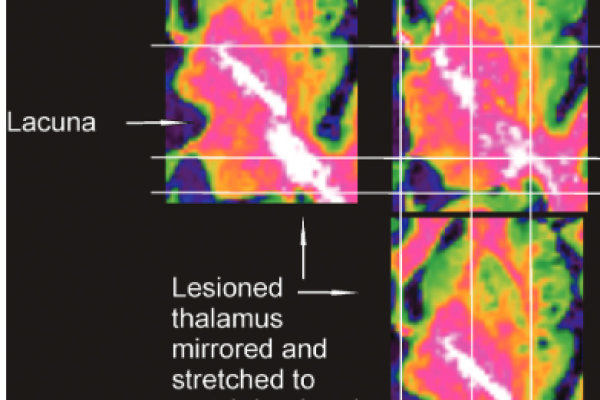2013-05-01

To a good extent the assessment of brain lesions in neuropsychological studies is still in its dark ages. Structural MRI-data are often grouped into arbitrary anatomical groups and are rarely analyzed with proper quantitative means that then can be correlated with assessments of cognitive decline. This problem is especially visible when it comes to thalamic lesions, where sometimes scientists lump most or at least major parts of the thalamus into a single basket. On the contrary, in animal research scientists have developed sophisticated techniques to quantify lesion loss for each and every anatomically identifiable nucleus. To overcome this problem, scientists from neuro- and biopsychology in Bochum teamed up and developed a procedure for a quantitative assessment of thalamic lesions in the chronic phase of an ischemic episode. The structural MR-images of 19 patients with ischemia in the thalamus were assessed by radiologic inspection. An independent rater allocated the damage to the each of the relevant thalamic nuclei. The assessments showed 89% accordance with the radiologic inspection. This procedure ranks the extent of the damage to thalamic nuclei and accounts for postacute rearrangement of the neural tissue. It will hopefully enable improved analyses in future studies that investigate cognitive effects of brain damages in patients.

To a good extent the assessment of brain lesions in neuropsychological studies is still in its dark ages. Structural MRI-data are often grouped into arbitrary anatomical groups and are rarely analyzed with proper quantitative means that then can be correlated with assessments of cognitive decline. This problem is especially visible when it comes to thalamic lesions, where sometimes scientists lump most or at least major parts of the thalamus into a single basket. On the contrary, in animal research scientists have developed sophisticated techniques to quantify lesion loss for each and every anatomically identifiable nucleus. To overcome this problem, scientists from neuro- and biopsychology in Bochum teamed up and developed a procedure for a quantitative assessment of thalamic lesions in the chronic phase of an ischemic episode. The structural MR-images of 19 patients with ischemia in the thalamus were assessed by radiologic inspection. An independent rater allocated the damage to the each of the relevant thalamic nuclei. The assessments showed 89% accordance with the radiologic inspection. This procedure ranks the extent of the damage to thalamic nuclei and accounts for postacute rearrangement of the neural tissue. It will hopefully enable improved analyses in future studies that investigate cognitive effects of brain damages in patients.